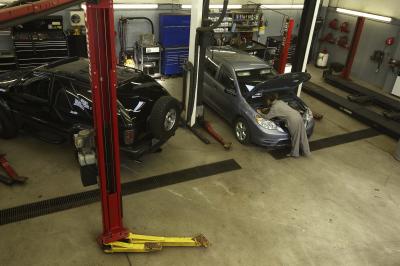
A leak in a power steering hose is risky in itself, but because there is pressure on the hose, it can be a very dramatic experience. Power steering fluid can rapidly exit the system and land on hot parts of the engine, causing a smoke show and loss of control of the vehicle due to loss of power in the steering system. Therefore, it is best if you can check this hose whenever you change the oil or perform other maintenance under the hood.
Park the vehicle and allow the engine and other parts to cool down if necessary, to avoid burn injuries. Find the high-pressure hose (return hose) that carries the power-steering fluid from the pump to the power steering rack. This will be the hose with threaded fittings on the ends. Spray some penetrating oil (Liquid Wrench or WD-40) on the fittings connected to the power steering box or rack.
Put a drain pan underneath the lowest point of the pressure hose. Unscrew the hose fitting or bolt from the power-steering box using a flare-nut wrench, and then remove the return hose to allow the fluid to drain from the hose. Plug the area where you removed the hose with a rag.
Remove the other end of the power steering hose by removing all the additional fittings (clips, clamps, shields) from the pump and steering gear box, using a flare-nut wrench and screwdriver, and then cap areas such as the pump with a rag to prevent leaks.
Reverse the steps to install the new power steering hose, being sure to position the hoses where they will not come into direct contact with other components. Re-install all fittings (clips, clamps, shields) in their proper place and tighten according to the manufacturer’s specification. Add power steering fluid to the reservoir until it reaches the cold level indicator in the reservoir or on the dipstick.
Start the vehicle, and then start bleeding air from the power steering system by turning the wheel, causing it to lock (sharp turns) a few times. Check the fluid level in the power steering reservoir and repeat this process until the system is free of air.